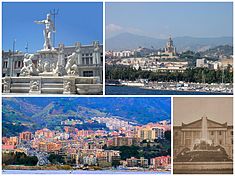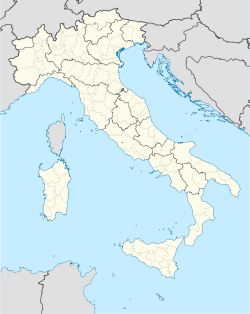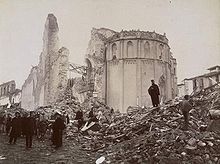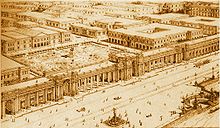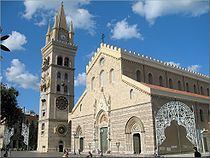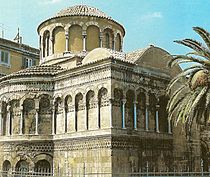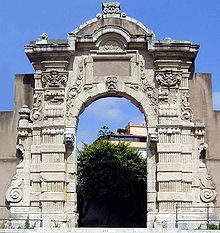- Messina
-
This article is about the city in Sicily, Italy. For the city in South Africa, see Musina. For other uses, see Messina (disambiguation).
Messina — Comune — Comune di Messina A collage of Messina 
Flag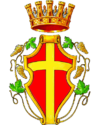
Coat of armsLocation of Messina in Italy Coordinates: 38°11′N 15°33′E / 38.183°N 15.55°E Country Italy Region Sicily Province Messina Area - Total 211.2 km2 (81.5 sq mi) Elevation 3 m (10 ft) Population (May 2009[1]) - Total 243,252 - Density 1,151.8/km2 (2,983/sq mi) Demonym Messinesi, Peloritani Time zone CET (UTC+1) - Summer (DST) CEST (UTC+2) Postal code 98100 Dialing code 090 Patron saint Madonna of the Letter Saint day 3 June Website Official website Messina (Italian pronunciation: [mesˈsiːna] (
 listen), Sicilian: Missina) is the third largest city on the island of Sicily, Italy and the capital of the province of Messina. It has a population of about 250,000 inhabitants in the city proper and about 650,000 in the province. It is located near the northeast corner of Sicily, at the Strait of Messina, just opposite Villa San Giovanni on the mainland.
listen), Sicilian: Missina) is the third largest city on the island of Sicily, Italy and the capital of the province of Messina. It has a population of about 250,000 inhabitants in the city proper and about 650,000 in the province. It is located near the northeast corner of Sicily, at the Strait of Messina, just opposite Villa San Giovanni on the mainland.The main economical resources of the city are: the port (commercial and military), provided with several shipyards; agriculture (including wine production and the cultivation of lemons, oranges, mandarin oranges and olives); tourism.
The city has been a Roman Catholic Archdiocese and Archimandrite seat since 1548 and is home to a locally important international fair.
Contents
History
Founded by Greek colonists in the 8th century BC, Messina was originally called Zancle, from the Greek: ζάγκλον meaning "scythe" because of the shape of its natural harbour (though a legend attributes the name to King Zanclus). A comune of its province, located at the southern entrance of the Strait of Messina, is to this day called 'Scaletta Zanclea'. In the early 5th century BC, Anaxilas of Rhegium renamed it Messene in honour of the Greek city Messene (Greek: Μεσσήνη). (See also List of traditional Greek place names.) The city was sacked in 397 BC by the Carthaginians and then reconquered by Dionysius I of Syracuse.
In 288 BC the Mamertines seized the city by treachery, killing all the men and taking the women as their wives. The city became a base from which they ravaged the countryside, leading to a conflict with the expanding regional empire of Syracuse. Hiero II, tyrant of Syracuse, defeated the Mamertines near Mylae on the Longanus River and besieged Messina. Carthage assisted the Mamertines because of a long-standing conflict with Syracuse over dominance in Sicily. When Hiero attacked a second time in 264 BC, the Mamertines petitioned the Roman Republic for an alliance, hoping for more reliable protection. Although initially reluctant to assist lest it encourage other mercenary groups to mutiny, Rome was unwilling to see Carthaginian power spread further over Sicily and encroach on Italy. Rome therefore entered into an alliance with the Mamertines. In 264 BC, Roman troops were deployed to Sicily, the first time a Roman army acted outside the Italian Peninsula.
At the end of the First Punic War it was a free city allied with Rome. In Roman times Messina, then known as Messana, had an important pharos (lighthouse). Messana was the base of Sextus Pompeius, during his war against Octavian.
After the fall of the Roman Empire, the city was successively ruled by [Goths]] from 476, then by the Byzantine Empire in 535, by the Arabs in 842, and in 1061 by the Norman brothers Robert Guiscard and Roger Guiscard (later count Roger I of Sicily). In 1189 the English King Richard I, ("The Lionheart") stopped at Messina en route to the Holy Land and briefly occupied the city after a dispute over the dowry of his sister, who had been married to William the Good, King of Sicily
Messina was most likely the harbour at which the Black Death entered Europe: the plague was brought by Genoese ships coming from Caffa in the Crimea. In 1548 St. Ignatius founded there the first Jesuit college of the world, which later gave birth to the Studium Generale (the current University of Messina).
The Christian ships that won the Battle of Lepanto (1571) left from Messina: the Spanish author Miguel de Cervantes, who took part in the battle, recovered for some time in the Grand Hospital. The city reached the peak of its splendour in the early 17th century, under Spanish domination: at the time it was one of the ten greatest cities in Europe. In 1674 the city rebelled against the foreign garrison. It managed to remain independent for some time, thanks to the help of the French king Louis XIV, but in 1678, with the Peace of Nijmegen, it was reconquered by the Spaniards and sacked: the university, the senate and all the privileges of autonomy it had enjoyed since the Roman times were abolished. A massive fortress was built by the occupants and Messina decayed steadily. In 1743, 48,000 died of plague in Messina.[2] In 1783, an earthquake devastated much of the city, and it took decades to rebuild and rekindle the cultural life of Messina.
In 1847 it was one of the first cities in Italy where Risorgimento riots broke out. In 1848 it rebelled openly against the reigning Bourbons, but was heavily suppressed again. Only in 1860, after the Battle of Milazzo, the Garibaldine troops occupied the city. One of the main figures of the unification of Italy, Giuseppe Mazzini, was elected deputy at Messina in the general elections of 1866.
Another earthquake of less intensity damaged the city on November 16, 1894.
The city was almost entirely destroyed by an earthquake and associated tsunami on the morning of December 28, 1908, killing about 60,000 people and destroying most of the ancient architecture. The city was largely rebuilt in the following year, according to a more modern and rational plan. It incurred further damage from the massive Allied air bombardments of 1943, which caused thousands of deaths. Later, the city gained a Gold Medal for Military Valour and one for Civil Valour in memory of the event and the subsequent effort of reconstruction.
In June 1955, Messina was the location of the Messina Conference of Western European foreign ministers which led to the creation of the European Economic Community.[3]
Not well known to the community of railfans, Messina has a light rail system that was opened on April 3, 2003. This line is 7.7 kilometres (4.8 mi) and links the city's central railway station with the city centre and harbour. Low floor double-ended trams built by Alston Ferroviaria.
Climate
Climate data for Messina Month Jan Feb Mar Apr May Jun Jul Aug Sep Oct Nov Dec Year Average high °C (°F) 14
(57)14
(57)15
(59)17
(63)21
(70)26
(79)29
(84)29
(84)27
(81)22
(72)18
(64)15
(59)21 Daily mean °C (°F) 12
(54)12
(54)13
(55)15
(59)19
(66)23
(73)26
(79)27
(81)24
(75)20
(68)16
(61)13
(55)18 Average low °C (°F) 10
(50)10
(50)11
(52)12
(54)16
(61)20
(68)23
(73)24
(75)21
(70)18
(64)14
(57)11
(52)16 Precipitation cm (inches) 11
(4.3)10
(3.9)8
(3.1)5
(2)3
(1.2)1
(0.4)1
(0.4)2
(0.8)5
(2)10
(3.9)10
(3.9)11
(4.3)84
(33.1)Source: Weatherbase[4] Main sights
Churches and sanctuaries
- The Cathedral (12th century), containing the remains of king Conrad, ruler of Germany and Sicily in the 13th century. The building had to be almost entirely rebuilt in 1919-1920, following the devastating 1908 earthquake, and again in 1943, after a fire triggered by Allied bombings. The original Norman structure can be recognised in the apsidal area. The façade has three late Gothic portals, the central of which probably dates back to the early 15th century. The architrave is decorated with a sculpture of Christ Among the Evangelists and various representations of men, animals and plants. The tympanum dates back to 1468. The interior is organised in a nave and two equally long aisles divided by files of 28 columns. Some decorative elements belong the original building, whereas the mosaics in the apse are reconstructions. Tombs of illustrious men besides Conrad IV, include those of Archbishops Palmer (died in 1195), Guidotto de Abbiate (14th century) and Antonio La Legname (16th century). Special interest is held by the Chapel of the Sacrament (late 16th century), with scenic decorations and 14th century mosaics. The bell tower holds one of the largest astronomical clocks in the world, built in 1933 by the Ungerer Company of Strasbourg. The belfry mechanically animated statues, which illustrate events from the civil and religious history of the city every day at noon, are a popular touristic attraction.
- Annunziata dei Catalani (late 12th-13th century). Dating from the late Norman period, it was transformed in the 13th century when the nave was shortened and the façade added. It has a cylindrical apse and a high dome emerging from a high tambour. Noteworthy is the external decoration of the transept and the dome area, with a series of blind arches separated by small columns. It clearly reflects Arabic architectural influences.
- Santa Maria degli Alemanni (early 13th century), which was formerly a chapel of Teutonic Knights. It is a rare example of pure Gothic architecture in Sicily, as is witnessed by the arched windows and shapely buttresses.
- Sanctuary of Santa Maria del Carmelo (near the Courthouse) built in 1931, which contains a 17th-century statue of the Virgin Mary.
- Sanctuary of Montevergine, where the incorrupt body of Saint Eustochia Smeralda Calafato is preserved.
Fountains
- The Fountain of Orion, located next to the Cathedral, built by Giovanni Angelo Montorsoli in 1547.
- The Fountain of Neptune, looking towards the harbour, built by Montorsoli in 1557.
- The Senatory Fountain (1619)
- Quattro Fontane (The Four Fountains), though only two elements of the four-cornered complex survive today.
Other landmarks
- The San Ranieri lighthouse (1555).
- The Botanical Garden "Pietro Castelli" of the University of Messina.
- Palazzo Calapaj, an example of 18th century Messinese architecture which survived to the 1908 earthquake.
- Porta Grazia, 16th century gate of "real cittadella di Messina", a still existing fortress in the harbour
- The Pylon, built in 1957 together with a twin located across the Strait of Messina, to carry a 220kV-overhead powerline bringing electric power to the island. At the time of their construction, the two electric pylons were the highest in the world. The powerline has later been replaced by an underwater cable, but the pylon still stands as a freely accessible tourist attraction.
Museums
- The Regional Museum, hosting notable paintings by Caravaggio [5] and Antonello da Messina.
- Museum of popular culture and music (Museo di cultura e musica popolare dei Peloritani), devoted to the local ethnomusicological tradition.
Notable people
- Antonello da Messina, painter of the Renaissance, born in Messina in 1430.
- Dicaearchus, Greek philosopher and mathematician, born in Messina in 350 BC.
- Eustochia Smeralda Calafato, saint, born in Messina in 1434.
- Francesco Maurolico, astronomer and mathematician, of Greek origin, born in Messina in 1494.
- Bernardo Storace, composer, worked in Messina in 1664.
- Filippo Juvarra, architect and highest exponent of the Baroque, born in Messina in 1678.
- Annibale Maria Di Francia, saint, born in Messina in 1851.
- Giuseppe Sergi, anthropologist, born in Messina in 1841.
- Luigi Rizzo, naval officer and First World War hero, born in Messina in 1887.
- Maria Grazia Cucinotta, actress, born in Messina in 1968.
- Vincenzo Nibali, cyclist, born in Messina in 1984.
- Vincenzo Tripodo, photographer, opera director, and filmmaker.
Literary references
Numerous writers set their works in Messina, including:
- Plutarch - The Life of Pompey (40 BC?)
- Giovanni Boccaccio - Decameron IV day V novel, Lisabetta da Messina - IV day IV Novel, Gerbino ed Elissa (1351)
- Matteo Bandello - Novelliere First Part, novel XXII (1554)
- William Shakespeare - Much Ado about Nothing (1598) and Antony and Cleopatra (1607)
- Molière - L'Etourdi ou Les Contre-temps (1654)
- Friedrich Schiller - Die Braut von Messina (The Bride of Messina, 1803)
- Silvio Pellico - Eufemio da Messina (1818)
- Friedrich Nietzsche - Idyllen aus Messina (Idylls from Messina, 1882)
- Giovanni Pascoli - poem L'Aquilone (1904)
- Elio Vittorini - Le donne di Messina (Women of Messina, 1949) and Conversazione in Sicilia (Conversations in Sicily, 1941)
- Stefano D'Arrigo - Horcynus Orca (1975)
- Julien Green - Demain n'existe pas (1985)
See also
- A.C.R. Messina
- Messina Centrale railway station
- Messina Grand Prix
- International Rally of Messina
Notes
- ^ Data from ISTAT
- ^ Epidemiology of the Black Death and Successive Waves of Plague. Samuel K Cohn JR. Medical History.
- ^ "''The Messina Declaration 1955'' final document of ''The Conference of Messina'' 1 to 3 June 1955 - birth of the European Union". Eu-history.leidenuniv.nl. http://www.eu-history.leidenuniv.nl/index.php3?m=10&c=52. Retrieved 2011-04-05.
- ^ "Weatherbase: Historical Weather for Messina". http://www.weatherbase.com/weather/weatherall.php3?s=2461&refer=&units=metric.
- ^ "Regione Siciliana Assessorato Beni Culturali". Regione.sicilia.it. http://www.regione.sicilia.it/beniculturali/dirbenicult/info/BeniInamovibili/MeCaravaggio.html. Retrieved 2011-04-05.
External links
- Official Municipality website (Italian)
- Messina website (Italian)
- Messina News (Italian)
- University website (Italian)
- Prefettura website (Italian)
- Catholic Archdiocese of Messina-Lipari-Santa Lucia del Mela (Italian)
- Chamber of Commerce website (Italian)
- Theatre of Messina Vittorio Emanuele (Italian)
- International Trade Fair website (Italian)
- All about sport in Messina (Italian)
- Messina Port Authority (Italian)
Categories:- Cities and towns in Sicily
- Municipalities of the Province of Messina
- Messina
- Ancient Greek cities
- Coastal cities and towns in Italy
- Cumaean colonies
- Euboean colonies of Magna Graecia
- Mediterranean port cities and towns in Italy
- Populated places established in the 8th century BC
Wikimedia Foundation. 2010.

